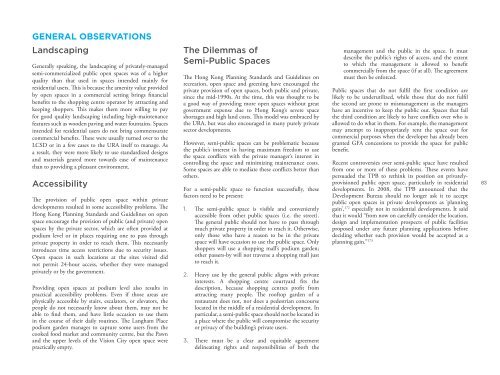Treating the Symptoms - A Critical Review of ... - Civic Exchange
Treating the Symptoms - A Critical Review of ... - Civic Exchange
Treating the Symptoms - A Critical Review of ... - Civic Exchange
- No tags were found...
You also want an ePaper? Increase the reach of your titles
YUMPU automatically turns print PDFs into web optimized ePapers that Google loves.
General ObservationsLandscapingGenerally speaking, <strong>the</strong> landscaping <strong>of</strong> privately-managedsemi-commercialized public open spaces was <strong>of</strong> a higherquality than that used in spaces intended mainly forresidential users. This is because <strong>the</strong> amenity value providedby open spaces in a commercial setting brings financialbenefits to <strong>the</strong> shopping centre operator by attracting andkeeping shoppers. This makes <strong>the</strong>m more willing to payfor good quality landscaping including high-maintenancefeatures such as wooden paving and water fountains. Spacesintended for residential users do not bring commensuratecommercial benefits. These were usually turned over to <strong>the</strong>LCSD or in a few cases to <strong>the</strong> URA itself to manage. Asa result, <strong>the</strong>y were more likely to use standardized designsand materials geared more towards ease <strong>of</strong> maintenancethan to providing a pleasant environment.AccessibilityThe provision <strong>of</strong> public open space within privatedevelopments resulted in some accessibility problems. TheHong Kong Planning Standards and Guidelines on openspace encourage <strong>the</strong> provision <strong>of</strong> public (and private) openspaces by <strong>the</strong> private sector, which are <strong>of</strong>ten provided atpodium level or in places requiring one to pass throughprivate property in order to reach <strong>the</strong>m. This necessarilyintroduces time access restrictions due to security issues.Open spaces in such locations at <strong>the</strong> sites visited didnot permit 24-hour access, whe<strong>the</strong>r <strong>the</strong>y were managedprivately or by <strong>the</strong> government.Providing open spaces at podium level also results inpractical accessibility problems. Even if those areas arephysically accessible by stairs, escalators, or elevators, <strong>the</strong>people do not necessarily know about <strong>the</strong>m, may not beable to find <strong>the</strong>m, and have little occasion to use <strong>the</strong>min <strong>the</strong> course <strong>of</strong> <strong>the</strong>ir daily routines. The Langham Placepodium garden manages to capture some users from <strong>the</strong>cooked food market and community centre, but <strong>the</strong> Pawnand <strong>the</strong> upper levels <strong>of</strong> <strong>the</strong> Vision City open space werepractically empty.The Dilemmas <strong>of</strong>Semi-Public SpacesThe Hong Kong Planning Standards and Guidelines onrecreation, open space and greening have encouraged <strong>the</strong>private provision <strong>of</strong> open spaces, both public and private,since <strong>the</strong> mid-1990s. At <strong>the</strong> time, this was thought to bea good way <strong>of</strong> providing more open spaces without greatgovernment expense due to Hong Kong’s severe spaceshortages and high land costs. This model was embraced by<strong>the</strong> URA, but was also encouraged in many purely privatesector developments.However, semi-public spaces can be problematic because<strong>the</strong> public’s interest in having maximum freedom to use<strong>the</strong> space conflicts with <strong>the</strong> private manager’s interest incontrolling <strong>the</strong> space and minimizing maintenance costs.Some spaces are able to mediate <strong>the</strong>se conflicts better thano<strong>the</strong>rs.For a semi-public space to function successfully, <strong>the</strong>sefactors need to be present:1. The semi-public space is visible and convenientlyaccessible from o<strong>the</strong>r public spaces (i.e. <strong>the</strong> street).The general public should not have to pass throughmuch private property in order to reach it. O<strong>the</strong>rwise,only those who have a reason to be in <strong>the</strong> privatespace will have occasion to use <strong>the</strong> public space. Onlyshoppers will use a shopping mall’s podium garden;o<strong>the</strong>r passers-by will not traverse a shopping mall justto reach it.2.3.Heavy use by <strong>the</strong> general public aligns with privateinterests. A shopping centre courtyard fits <strong>the</strong>description, because shopping centres pr<strong>of</strong>it fromattracting many people. The ro<strong>of</strong>top garden <strong>of</strong> arestaurant does not, nor does a pedestrian concourselocated in <strong>the</strong> middle <strong>of</strong> a residential development. Inparticular, a semi-public space should not be located ina place where <strong>the</strong> public will compromise <strong>the</strong> securityor privacy <strong>of</strong> <strong>the</strong> building’s private users.There must be a clear and equitable agreementdelineating rights and responsibilities <strong>of</strong> both <strong>the</strong>management and <strong>the</strong> public in <strong>the</strong> space. It mustdescribe <strong>the</strong> public’s rights <strong>of</strong> access, and <strong>the</strong> extentto which <strong>the</strong> management is allowed to benefitcommercially from <strong>the</strong> space (if at all). The agreementmust <strong>the</strong>n be enforced.Public spaces that do not fulfil <strong>the</strong> first condition arelikely to be underutilized, while those that do not fulfil<strong>the</strong> second are prone to mismanagement as <strong>the</strong> managershave an incentive to keep <strong>the</strong> public out. Spaces that fail<strong>the</strong> third condition are likely to have conflicts over who isallowed to do what in <strong>the</strong>m. For example, <strong>the</strong> managementmay attempt to inappropriately rent <strong>the</strong> space out forcommercial purposes when <strong>the</strong> developer has already beengranted GFA concessions to provide <strong>the</strong> space for publicbenefit.Recent controversies over semi-public space have resultedfrom one or more <strong>of</strong> <strong>the</strong>se problems. These events havepersuaded <strong>the</strong> TPB to rethink its position on privatelyprovisionedpublic open space, particularly in residentialdevelopments. In 2008, <strong>the</strong> TPB announced that <strong>the</strong>Development Bureau should no longer ask it to acceptpublic open spaces in private developments as ‘planninggain’, 172 especially not in residential developments. It saidthat it would “from now on carefully consider <strong>the</strong> location,design and implementation prospects <strong>of</strong> public facilitiesproposed under any future planning applications beforedeciding whe<strong>the</strong>r such provision would be accepted as aplanning gain.” 17383
















